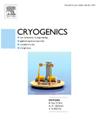Design and analysis of the components of cryogenic extruder for producing liquid hydrogen
IF 1.8
3区 工程技术
Q3 PHYSICS, APPLIED
引用次数: 0
Abstract
The Cryogenic Extruder (CE) is an extruder technology which can continuously produce solid rods of hydrogen and its isotopes. The solid rod is further cut into small cylindrical pieces called pellets, which are used for the fuelling of the long-pulse fusion reactors by injecting at high velocity into the magnetically confined, hot plasma, for the core-fuelling and D-T reaction. The design and analysis of a cryogenic extruder involves optimization of the various parameters of its different components such as precoolers, liquefier and solidifier compatible with cryogenic temperature operation. In this work, a design approach and Computation Fluid Dynamics (CFD) analysis of the components of extruder system is presented. The liquefier is designed to operate at a temperature of < 21 K and cooled using the 2nd stage of the cold head of a GM cryocooler. It has a compact shell which has an array of fins for the cooling down and liquefaction of the hydrogen gas to liquid. Theoretically, the surface temperature of 20.4 K is sufficient to produce liquid for the extrusion rate of 500 mm3/s of solid hydrogen but the CFD studies showed that the liquefier can produce the liquid for up to 1.75E-5 kg/s i.e., equivalent to 200 mm3/s of solid hydrogen based on the available cooling capacity of a cryocooler.
液态氢低温挤出机部件的设计与分析
低温挤出机(CE)是一种可以连续生产氢及其同位素固体棒的挤出技术。固体棒进一步被切割成小的圆柱形碎片,称为球团,用于长脉冲聚变反应堆的燃料,通过高速注入磁力受限的热等离子体,用于堆芯燃料和D-T反应。低温挤出机的设计和分析涉及到与低温操作相适应的预冷器、液化器和固化器等不同部件的各种参数的优化。本文介绍了挤出机系统部件的设计方法和计算流体动力学(CFD)分析。液化器的设计工作温度为<;21 K,并使用通用制冷机冷头的第二级冷却。它有一个紧凑的外壳,上面有一排鳍片,用于冷却和液化氢气成液体。理论上,20.4 K的表面温度足以产生500 mm3/s的固体氢挤压速率的液体,但CFD研究表明,液化器可以产生高达1.75E-5 kg/s的液体,即根据制冷机的可用冷却能力,相当于200 mm3/s的固体氢。
本文章由计算机程序翻译,如有差异,请以英文原文为准。
求助全文
约1分钟内获得全文
求助全文
来源期刊

Cryogenics
物理-热力学
CiteScore
3.80
自引率
9.50%
发文量
0
审稿时长
2.1 months
期刊介绍:
Cryogenics is the world''s leading journal focusing on all aspects of cryoengineering and cryogenics. Papers published in Cryogenics cover a wide variety of subjects in low temperature engineering and research. Among the areas covered are:
- Applications of superconductivity: magnets, electronics, devices
- Superconductors and their properties
- Properties of materials: metals, alloys, composites, polymers, insulations
- New applications of cryogenic technology to processes, devices, machinery
- Refrigeration and liquefaction technology
- Thermodynamics
- Fluid properties and fluid mechanics
- Heat transfer
- Thermometry and measurement science
- Cryogenics in medicine
- Cryoelectronics
 求助内容:
求助内容: 应助结果提醒方式:
应助结果提醒方式:


